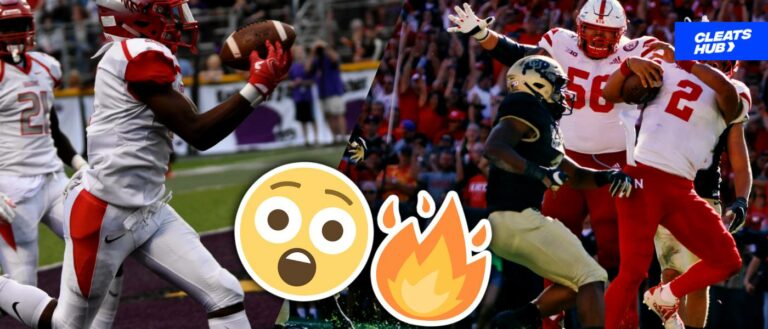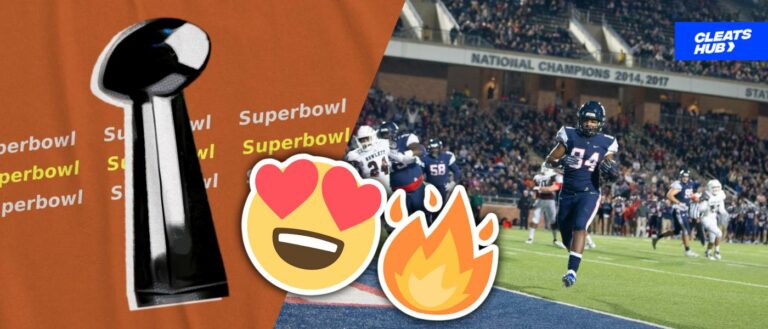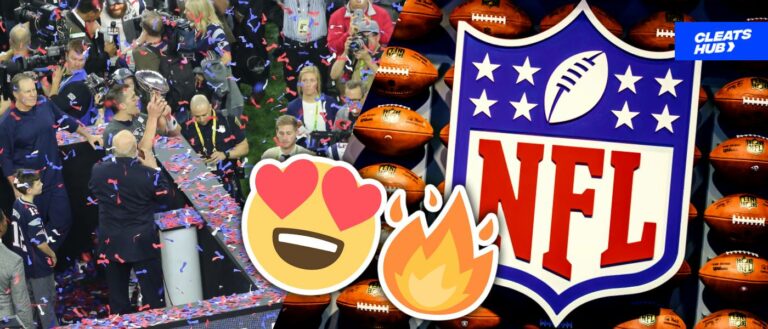What Are Running Backs And Fullbacks In American Football?
Running backs and fullbacks are key players in an offense in the exciting game of American football. They are generally in charge of gaining yards, carrying the ball, and launching a ground assault.
Here at Cleats Hub, we will discuss the functions, duties, and abilities of running backs and fullbacks.
What are Running Backs and Full Backs?
Running backs are very adaptable athletes who line up in the offensive backfield and are largely in charge of carrying the ball and generating yards on the ground.
Secondly, they have agility, speed, and vision, which enable them to move through defensive alignments, avoid tackles, and take advantage of running lanes.
Meanwhile, fullbacks line up in the backfield and are best at blocking and giving the running back lead blocks. Fullbacks are still crucial in short-yardage situations and goal-line stands even if their usage has decreased recently as a result of offensive scheme adjustments.
Role of Running Backs and Full Backs

Carrying the Ball
A running back’s main duty is to carry the ball and gain yards on the turf. To take advantage of defensive gaps, they must analyze the offensive line, locate running routes, and act swiftly.
Following Blocking Assignments
Running backs and fullbacks are required to adhere to the blocking assignments given by the offensive line and fullbacks.
In order to get the most yardage, they must read the blocks, modify their course, and take cuts. It’s crucial to have good timing and work well with the offensive line.
Pass Protection
Pass protection is the responsibility of the running backs and fullbacks on passing plays. They must recognize blitzes, learn their blocking responsibilities, and keep opponents from getting close to the quarterback.
Moreover, to neutralize pass rushers, this entails understanding the defensive alignment, coordinating with the offensive line, and executing blocks.
Short-Yardage Situations
Fullbacks frequently perform well in situations requiring only a few yards, such as goal-line stands or third-and-short plays. They are incredibly effective at obtaining the necessary yards and converting crucial downs.
Receiving Passes
In the passing game, running backs and fullbacks are engaged. They must follow exact routes, receive quarterback throws, and earn yards after the catch.
Moreover, success in the passing game depends on having good hands, being able to execute routes, and comprehending passing ideas.
Types of Running Backs and Full Backs
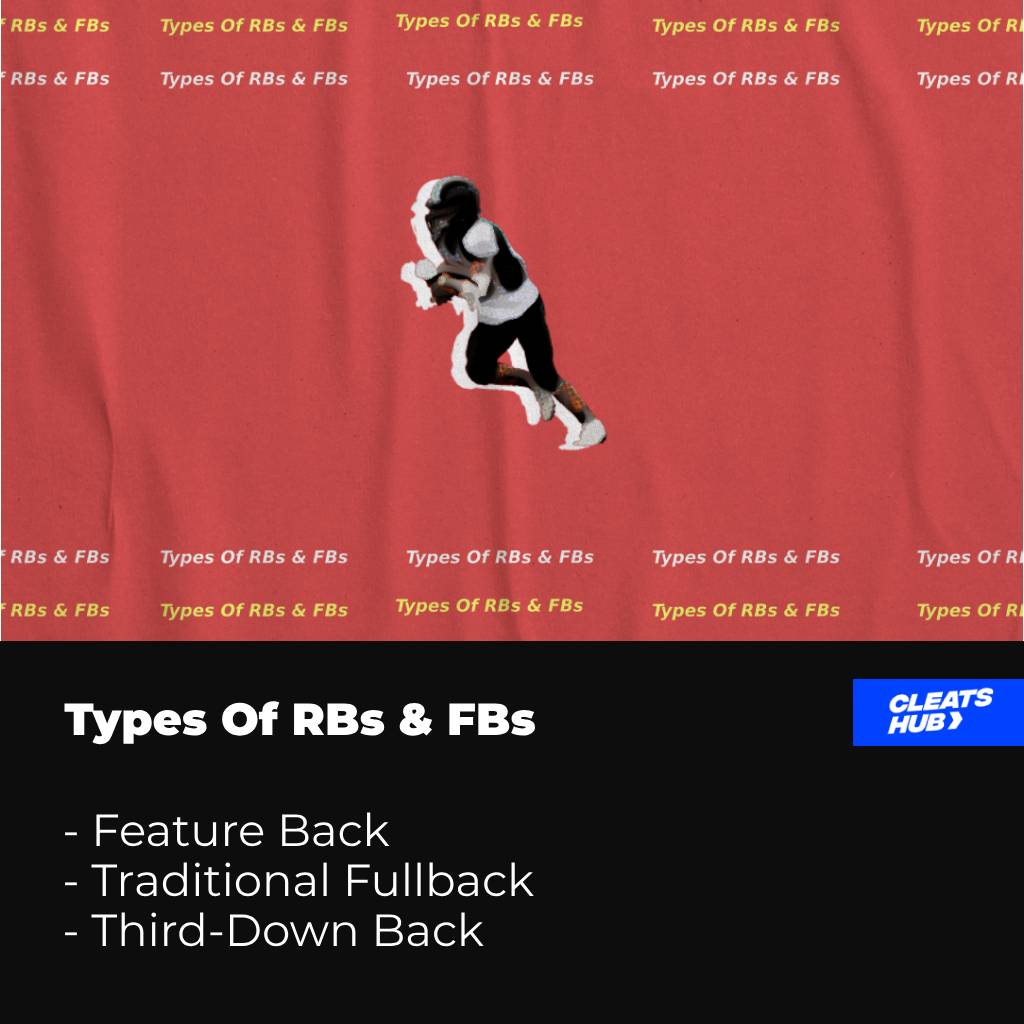
Let’s examine the many kinds of fullbacks and running backs:
Feature Back
A running back who is a team’s main ball carrier is referred to as a feature back. They are counted on to gain significant yards and have outstanding talents.
Additionally, these athletes are skilled at exploiting defensive weaknesses, avoiding tackles, and exhibiting outstanding elusiveness.
Third-Down Back
Backs on third down are also known as “change-of-pace” or “pass-catching” backs. Their primary responsibility is to grab passes out of the backfield and provide the quarterback an extra option on passing plays.
In addition, backs on third down are renowned for their nimbleness, route-running skills, and steady hands.
Power Back
The imposing forces at the running back position are power backs. They are exceptional at eluding opponents, breaking tackles, and earning difficult yards in tight circumstances.
Also, these athletes may overwhelm opposing defenders because of their size, strength, and powerful running style.
Traditional Fullback
Fullbacks with a traditional style are renowned for their strength and blocking ability. They are excellent at neutralizing linebackers and defensive linemen as well as lead blocking, opening up lanes for the running back.
Moreover, traditional fullbacks continue to be essential in goal-line stands and short-yardage situations despite the evolution of their position.
H-Back
A fullback and a tight end combined into one position, the H-back. H-backs can line up in a variety of spots, such as the backfield, close to the offensive line, or even while moving.
Additionally, they add flexibility to the offense by frequently providing running back protection or acting as a receiving threat in the passing game.
Skills of Great Running Backs and Full Backs
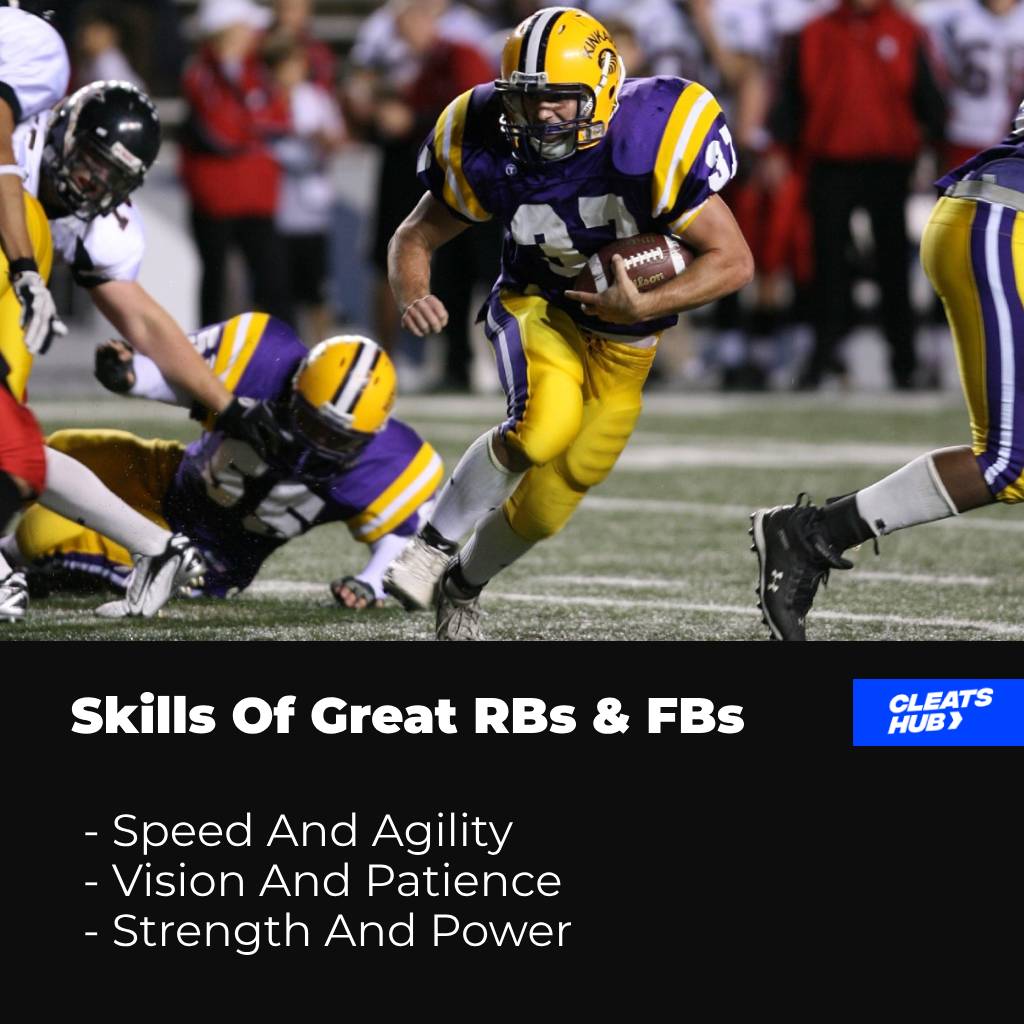
Running backs and fullbacks need to have a special set of abilities and qualities to be successful in their respective positions. Here are some essential traits for success:
Speed and Agility
Running backs must have fast feet and good agility so they can make rapid cuts, switch directions, and sprint through defensive gaps. They may evade tackling, pick up additional yards, and break huge runs because of this.
Vision and Patience
Running backs must possess great vision and patience. They must be able to survey the field rapidly, recognize running lanes, and make snap judgments.
Secondly, they can wait for blocks to form out of patience, which enables them to take advantage of defense weaknesses.
Strength and Power
Strong running backs can shed defenses, break tackles, and get difficult yards after impact. Success depends on their capacity to drop their shoulders, keep their legs moving, and strike opponents hard, especially in close quarters.
Blocking Technique
Fullbacks in particular need to be adept at blocking methods. To open up running lanes for the ball carrier, they must interact with the defenders, maintain good leverage, and push their legs.
Moreover, fullbacks should also have the intelligence to understand defensive plans and change their blocking responsibilities as necessary.
Rules that Running Backs and Full Backs have to follow?
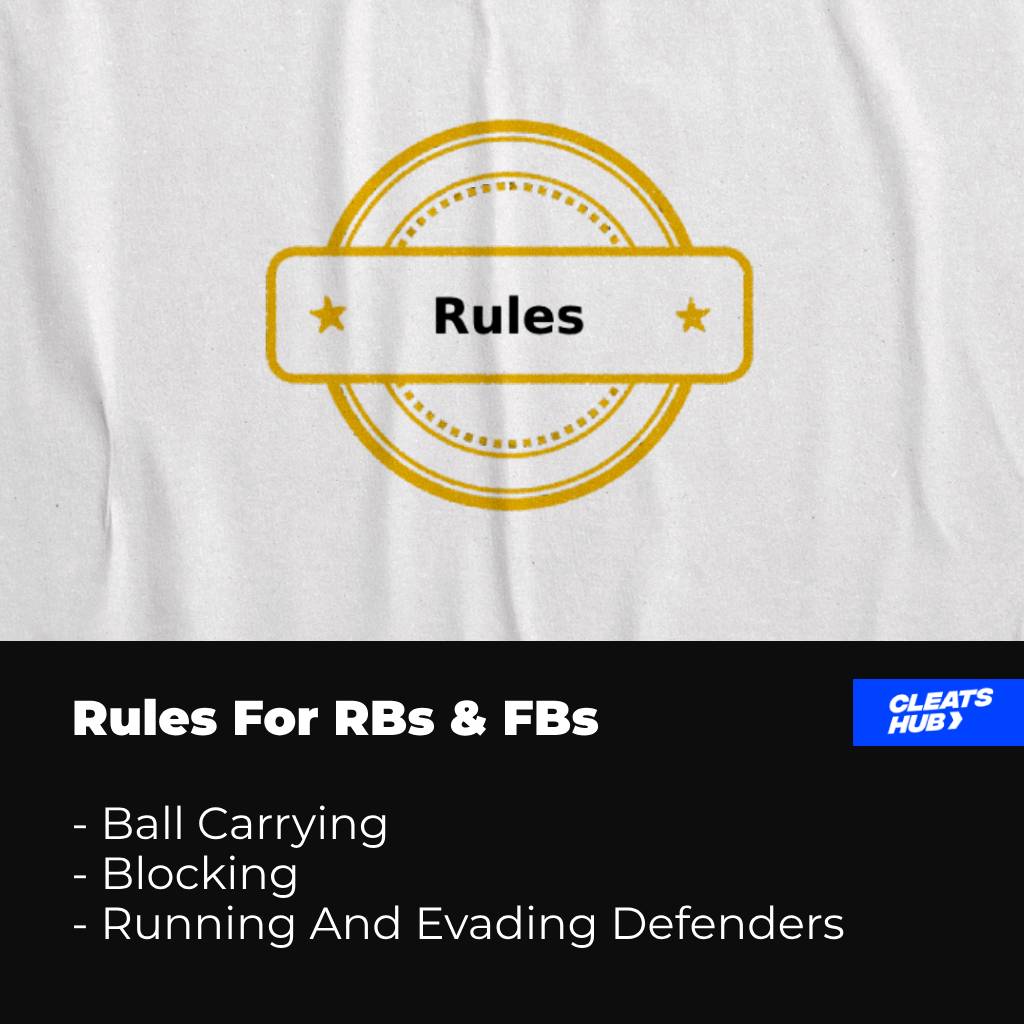
All players must abide by some general standards, but running backs and fullbacks are subject to additional regulations and obligations. Some important guidelines and factors for these professions are listed below:
Ball Carrying of Running backs and fullbacks
- To reduce the chance of fumbles, running backs and fullbacks must carry the ball securely with both hands around it and tucked against their bodies.
- They are not permitted to advance the ball with any other body part but their hands and arms. This implies they are unable to push off or make use of their helmet.
Blocking of Running backs and fullbacks
- Fullbacks play a key role in setting up the running back or shielding the quarterback during a throw.
- Running backs and fullbacks are both required to perform blocks by the rules, utilizing good technique and encircling opponents with their hands and arms.
- It is forbidden for offensive players to block below the waist or take aim at a defender’s head or neck. Illegal cut blocks and blindside blocks must be avoided.
Pass catching of Running backs and fullbacks
- In order to be considered eligible receivers, running backs and fullbacks must adhere to the same criteria as other receivers, including securing the ball, getting both feet inbounds (if necessary), and keeping possession during the reception.
- In order to avoid sanctions, they must also be informed of the laws governing pass interference, offensive pass interference, and prohibited touching.
Running and Evading Defenders of Running backs and fullbacks
- Running backs and fullbacks must attempt to avoid running out of bounds while on the move to keep the play going.
- They are unable to strike, swing, or push away defenders using their hands or arms. To preserve space, they can stiff-arm defenders with an open hand.
- The “helmet-to-helmet” hit, which is when an offensive player makes first contact with a defender utilizing the crown of their helmet, is prohibited.
Downfield Blocking of Running backs and fullbacks
- Running backs and fullbacks can block downfield to assist other offensive players gain yards even when they are not carrying the ball or participating in the pass play.
- They must block legally, and refrain from holding clipping, or unlawful back blocks.
Notable Running Backs and Full Backs in NFL History

Ranking the top five fullbacks and running backs in NFL history is arbitrary and depends on a person’s own preferences and selection criteria.
However, there are a few famous athletes who are renowned for being among the best at their positions.
The following list includes five fullbacks and running backs who have had a big effect on the game:
Jim Brown
Most people agree that Jim Brown is the best running back of all time. From 1957 until 1965, he was a member of the Cleveland Browns, when he dominated the league.
Moreover, Brown was renowned for having an excellent balance of strength, quickness, and size. He was the NFL’s leading rusher for eight seasons, garnering nine Pro Bowl appearances and three MVP honors.
William Payton
Between 1975 through 1987, Walter Payton sometimes referred to as “Sweetness,” played for the Chicago Bears. He was one of the most dynamic running backs in history thanks to a special combination of speed, agility, and tenacity.
In addition, Payton retired as the league’s all-time top rusher, having been chosen for nine Pro Bowls and winning one Super Bowl.
Jim Taylor
Jim Taylor, a powerful fullback noted for his tenacity and strength, was a Green Bay Packers player from 1958 to 1966. Under coach Vince Lombardi, he played a significant role in the Packers’ success and helped the club win several titles.
It is worth noting here that Taylor won the 1962 NFL MVP award after being selected five times for the Pro Bowl.
Franco Harris
Franco Harris was a talented fullback with the ability to produce as a runner and receiver. He is most remembered for his tenure with the Pittsburgh Steelers from 1972 to 1983.
Secondly, he was credited for helping the Steelers win four Super Bowls in the 1970s and was renowned for his “Immaculate Reception” during the postseason.
Moreover, Harris was a Super Bowl MVP and a nine-time Pro Bowler.
Barry Sanders
From 1989 until 1998, Barry Sanders, a running back for the Detroit Lions, was renowned for his deceptive style of play and exceptional quickness. He was swift, making him practically hard to contain.
Before his sudden retirement while still in his prime, Sanders was a four-time running champion and the recipient of 10 Pro Bowl nominations.
Conclusion
In conclusion, in American football, running backs and fullbacks are like the dynamic duo of the backfield, combining speed, power, and cunning to confuse opponents and excite spectators.
These positions are the driving force behind a ground assault, slicing through the defense’s mayhem, eluding tackles, and leaving a trail of shattered egos in their wake.
Running backs and fullbacks are what give American football that extra dash of flavor. They transform the field into their playground and leave a distinctive stamp on the gridiron.


